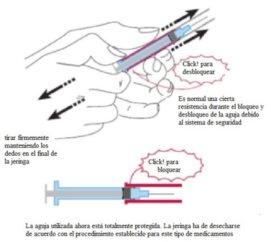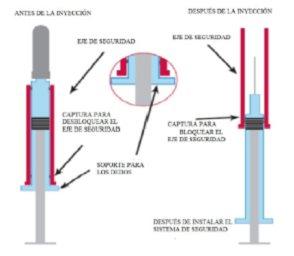
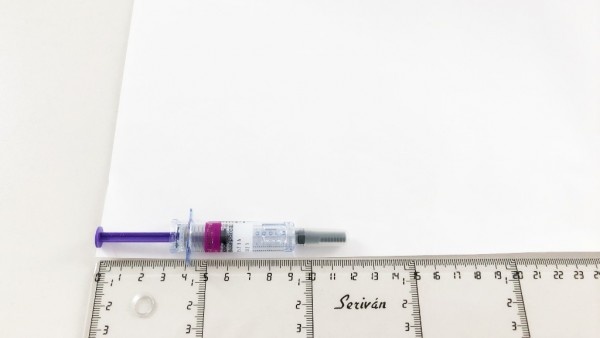
ГЕПАКСАН 12 000 МО (120 мг)/0,8 мл РОЗЧИН ДЛЯ ІН'ЄКЦІЙ У ПЕРЕДНАПОВНЕНИХ ШПРИЦАХ

Запитайте лікаря про рецепт на ГЕПАКСАН 12 000 МО (120 мг)/0,8 мл РОЗЧИН ДЛЯ ІН'ЄКЦІЙ У ПЕРЕДНАПОВНЕНИХ ШПРИЦАХ

Інструкція із застосування ГЕПАКСАН 12 000 МО (120 мг)/0,8 мл РОЗЧИН ДЛЯ ІН'ЄКЦІЙ У ПЕРЕДНАПОВНЕНИХ ШПРИЦАХ
Введення
Опис: інформація для користувача
Гепаксан 2 000 МО (20 мг)/0,2 мл розчин для ін'єкцій у попередньо заповненому шприці
Гепаксан 4 000 МО (40 мг)/0,4 мл розчин для ін'єкцій у попередньо заповненому шприці
Гепаксан 6 000 МО (60 мг)/0,6 мл розчин для ін'єкцій у попередньо заповненому шприці
Гепаксан 8 000 МО (80 мг)/0,8 мл розчин для ін'єкцій у попередньо заповненому шприці
Гепаксан 10 000 МО (100 мг)/1 мл розчин для ін'єкцій у попередньо заповненому шприці
Гепаксан 12 000 МО (120 мг)/0,8 мл розчин для ін'єкцій у попередньо заповненому шприці
Гепаксан 15 000 МО (150 мг)/1 мл розчин для ін'єкцій у попередньо заповненому шприці
Еноксапарин натрій
Прочитайте уважно весь опис перед тим, як почати використовувати цей лікарський засіб, оскільки він містить важливу інформацію для вас.
- Збережіть цей опис, оскільки вам може знадобитися знову його прочитати.
- Якщо у вас є якісь питання, проконсультуйтеся з вашим лікарем, фармацевтом або медсестрою.
- Цей лікарський засіб призначений тільки вам, і не слід давати його іншим людям, навіть якщо вони мають такі самі симптоми, як у вас, оскільки це може їм нашкодити.
- Якщо ви відчуваєте побічні ефекти, проконсультуйтеся з вашим лікарем або фармацевтом, навіть якщо це побічні ефекти, які не вказані в цьому описі. Див. розділ 4.
Зміст опису
- Що таке Гепаксан і для чого він використовується
- Що потрібно знати перед тим, як почати використовувати Гепаксан
- Як використовувати Гепаксан
- Можливі побічні ефекти
- Зберігання Гепаксану
- Зміст упаковки та додаткова інформація
1. Що таке Гепаксан і для чого він використовується
Гепаксан містить активну речовину еноксапарин натрій, яка є низькомолекулярною гепарином (НМГ).
Гепаксан діє двома способами:
- Запобігає зростанню вже існуючих кров'яних згустків. Це допомагає вашому організмові розчинити їх і не давати їм подальшої шкоди.
- Запобігає утворенню нових кров'яних згустків.
Гепаксан можна використовувати для:
- лікування кров'яних згустків.
- профілактики утворення кров'яних згустків у таких ситуаціях:
- до та після хірургічної операції.
- коли у вас є гостра хвороба і вам потрібно пережити період обмеженої рухливості
- якщо у вас утворилися кров'яні згустки через рак, для профілактики утворення нових згустків.
- коли у вас є нестабільна ангіна (хвороба, при якій не вистачає крові до серця).
- після інфаркту міокарда.
- профілактики утворення кров'яних згустків у трубках апарату для діалізу (який використовується у людей з серйозними проблемами нирок).
2. Що потрібно знати перед тим, як почати використовувати Гепаксан
Не використовуйте Гепаксан
- Якщо ви алергічні на еноксапарин натрій або на інші компоненти цього лікарського засобу (перелічені в розділі 6). Ознаки алергічної реакції включають: висип, проблеми з ковтанням або диханням, набряк губ, обличчя, горла або язика.
- Якщо ви алергічні на гепарин або на інші низькомолекулярні гепарини, такі як надропарин, тінзапарин або далтепарин.
- Якщо у вас була реакція на гепарин, яка викликала серйозне зниження кількості тромбоцитів – цю реакцію називають гепарин-індукованою тромбоцитопенією – протягом останніх 100 днів або якщо у вас є антитіла проти еноксапарину в крові.
- Якщо ви маєте сильне кровотечу або страждаєте на захворювання з високим ризиком кровотечі (такі як виразка шлунка, недавня хірургічна операція на мозку або очах), включаючи недавній геморагічний інсульт.
- Якщо ви використовуєте Гепаксан для лікування кров'яних згустків і плануєте отримати спінальну або епідуральну анестезію або лумбальну пункцію протягом 24 годин.
Попередження та застереження
Гепаксан не слід заміняти іншими лікарськими засобами, які належать до групи низькомолекулярних гепаринів. Це пов'язано з тим, що вони не є абсолютно ідентичними і не мають однакової активності та інструкцій використання.
Проконсультуйтеся з вашим лікарем або фармацевтом перед тим, як почати використовувати Гепаксан, якщо:
- ви раніше мали реакцію на гепарин, яка викликала серйозне зниження кількості тромбоцитів.
- ви плануєте отримати спінальну або епідуральну анестезію або лумбальну пункцію (див. «Хірургічні операції та анестезія»): слід дотримуватися певного часу між використанням Гепаксану та цими процедурами.
- вам імплантовано механічний клапан серця.
- у вас є ендокардит (інфекція внутрішньої оболонки серця).
- у вас є проблеми з шлунком.
- ви недавно мали інсульт (геморагічний інсульт).
- у вас є високий кров'яний тиск.
- у вас є цукровий діабет або проблеми з судинами ока, викликані цукровим діабетом (діабетична ретинопатія).
- ви недавно мали хірургічну операцію на очах або мозку.
- ви є людиною похилого віку ( старше 65 років) і особливо якщо вам більше 75 років.
- у вас є проблеми з нирками.
- у вас є проблеми з печінкою.
- у вас є дуже низька або надмірна вага.
- у вас є високий рівень калію в крові, який можна визначити за допомогою аналізу крові.
- ви зараз використовуєте лікарські засоби, які впливають на кровотечу (див. нижче «Інші лікарські засоби та Гепаксан»).
Вам може знадобитися проведення аналізу крові перед тим, як почати використовувати цей лікарський засіб, і під час його використання для визначення рівня тромбоцитів і рівня калію в крові.
Інші лікарські засоби та Гепаксан
Повідомте вашому лікареві або фармацевту, якщо ви використовуєте, недавно використовували або можете використовувати інші лікарські засоби.
- Варфарин, який використовується для зниження кров'яної коагуляції.
- Аспірин (також відомий як ацетилсаліцилова кислота або АСК), клопідогрел або інші лікарські засоби, які використовуються для запобігання утворення кров'яних згустків (див. також розділ 3 «Зміна антикоагулянтної терапії»).
- Декстрани, які використовуються як замінники крові.
- Ібупрофен, диклофенак, кеторолак або інші лікарські засоби, відомі як нестероїдні протизапальні засоби, які використовуються для лікування болю та запалення при артриті та інших захворюваннях.
- Преднізолон, дексаметазон та інші лікарські засоби, які використовуються для лікування астми, ревматоїдного артриту та інших захворювань.
- Лікарські засоби, які збільшують рівень калію в крові, такі як калієві солі, діуретики та деякі лікарські засоби для лікування серцевих захворювань.
Хірургічні операції та анестезія
Якщо вам мають провести лумбальну пункцію або ви плануєте хірургічну операцію, під час якої буде використовуватися спінальна або епідуральна анестезія, повідомте вашому лікареві, що ви використовуєте Гепаксан (див. «Не використовуйте Гепаксан»). Також повідомте вашому лікареві, якщо у вас є проблеми з хребцем або якщо ви раніше мали хірургічну операцію на хребці.
Вагітність та лактація
Якщо ви вагітні або годуєте грудьми, вважаєте, що можете бути вагітною або плануєте завагітніти, проконсультуйтеся з вашим лікарем або фармацевтом перед тим, як використовувати цей лікарський засіб.
Якщо ви вагітні та маєте механічний клапан серця, у вас може бути підвищений ризик утворення кров'яних згустків. Ваш лікар обговорить це питання з вами.
Водіння транспортних засобів та використання машин
Гепаксан не впливає на вашу здатність водити транспортні засоби та використовувати машини.
Гепаксан містить натрій
Цей лікарський засіб містить менше 1 ммоль натрію (23 мг) на дозу, тобто є «практично безнатрієвим».
Рекомендується, щоб лікар або фармацевт записав назву лікарського засобу та номер партії лікарського засобу, який ви використовуєте.
3. Як використовувати Гепаксан
Слідкуйте точно інструкціям щодо застосування цього лікарського засобу, вказаним вашим лікарем або фармацевтом. У разі сумнівів проконсультуйтеся знову з вашим лікарем або фармацевтом.
Застосування лікарського засобу
- Зазвичай ваш лікар або медсестра введуть Гепаксан. Це тому, що його потрібно вводити шляхом ін'єкції.
- Коли ви повернетеся додому, можливо, вам потрібно буде продовжувати використовувати Гепаксан і вводити його самостійно (див. інструкції щодо того, як це зробити).
- Гепаксан зазвичай вводять під шкіру (підшкірна ін'єкція).
- Гепаксан можна вводити в ваші вени (внутрішньовенне введення) після певних видів серцевих нападів і хірургічних операцій.
- Гепаксан можна додавати до трубки, яка виходить з тіла (артеріальна лінія), на початку сеансу діалізу.
Не вводьте Гепаксан у м'яз (внутрішньом'язова ін'єкція).
Яка кількість буде введена
- Ваш лікар вирішить, яку кількість Гепаксану буде введено. Кількість залежатиме від причини, з якою вам потрібно його використовувати.
- Якщо у вас є проблема з нирками, можливо, буде введена менша кількість Гепаксану.
- Лікування утворення кров'яних згустків:
- Звичайна доза становить 150 ОД (1,5 мг) на кілограм ваги тіла кожний день або 100 ОД (1 мг) на кілограм ваги тіла двічі на день.
- Ваш лікар вирішить, скільки часу ви будете отримувати Гепаксан.
- Переривання утворення кров'яних згустків у наступних ситуаціях:
- Операції або періоди обмеженої рухливості через захворювання
- Доза залежатиме від ймовірності того, що у вас розвинеться кров'яний згусток. Буде введено 2 000 ОД (20 мг) або 4 000 ОД (40 мг) Гепаксану на день.
- Якщо вам потрібно операція, зазвичай перша ін'єкція буде зроблена за 2 або 12 годин до операції.
- Якщо у вас обмежена рухливість через захворювання, зазвичай буде введено 4 000 ОД (40 мг) Гепаксану на день.
- Ваш лікар вирішить, скільки часу ви будете отримувати Гепаксан.
- Після того, як у вас стався серцевий напад
Гепаксан можна використовувати при двох різних типах серцевих нападів, які називаються ІАМЦЕСТ (інфаркт міокарда з підвищенням сегмента ST) або не ІАМЦЕСТ (ІАМСЕСТ). Кількість Гепаксану, яку потрібно вводити, залежатиме від віку та типу серцевого нападу, який у вас стався.
Серцевий напад типу ІАМСЕСТ:
- Звичайна доза становить 100 ОД (1 мг) на кілограм ваги тіла кожні 12 годин.
- Зазвичай ваш лікар скаже вам також приймати аспірин (ацетилсаліцилову кислоту).
- Ваш лікар вирішить, скільки часу ви будете отримувати Гепаксан.
Серцевий напад типу ІАМЦЕСТ, якщо вам менше 75 років:
- Буде зроблена перша ін'єкція Гепаксану в дозі 3 000 ОД (30 мг) внутрішньовенно.
- Одночасно буде зроблена ін'єкція Гепаксану під шкіру (підшкірна ін'єкція). Звичайна доза становить 100 ОД (1 мг) на кілограм ваги тіла кожні 12 годин.
- Зазвичай ваш лікар скаже вам також приймати аспірин (ацетилсаліцилову кислоту).
- Ваш лікар вирішить, скільки часу ви будете отримувати Гепаксан.
Серцевий напад типу ІАМЦЕСТ, якщо вам 75 років або більше:
- Звичайна доза становить 75 ОД (0,75 мг) на кілограм ваги тіла кожні 12 годин.
- Максимальна кількість Гепаксану, яка вводиться в перші дві ін'єкції, становить 7 500 ОД (75 мг).
- Ваш лікар вирішить, скільки часу ви будете отримувати Гепаксан.
Якщо вам потрібно коронарне втручання:
В залежності від того, коли була зроблена остання ін'єкція Гепаксану, ваш лікар може вирішити зробити додаткову ін'єкцію Гепаксану перед коронарним втручанням. Це буде зроблено внутрішньовенно.
- Переривання утворення кров'яних згустків у трубках апарату діалізу
- Звичайна доза становить 100 ОД (1 мг) на кілограм ваги тіла.
- Гепаксан додається до трубки, яка виходить з тіла (артеріальна лінія), на початку сеансу діалізу. Ця кількість зазвичай достатня для сеансу тривалістю 4 години. Однак ваш лікар може зробити повторну ін'єкцію у дозі 50 ОД до 100 ОД (0,5 до 1 мг) на кілограм ваги тіла, якщо це необхідно.
Форма застосування
Шприц-картридж готовий до використання.
Цей лікарський засіб не повинен застосовуватися внутрішньом'язово.
Введення через артеріальну лінію екстракорпоральної системи
Для профілактики утворення кров'яних згустків у трубках апарату діалізу цей лікарський засіб вводиться в трубку, яка виходить з тіла (артеріальна лінія).
Техніка внутрішньовенної ін'єкції [тільки для показання інфаркту міокарда з підвищенням сегмента ST (ІАМЦЕСТ)]
При лікуванні гострого ІАМЦЕСТ лікування повинно розпочинатися з єдиної швидкої ін'єкції в вену (внутрішньовенна ін'єкція), після чого негайно слідує ін'єкція під шкіру (підшкірна ін'єкція).
Техніка підшкірної ін'єкції (введення під шкіру)
Цей лікарський засіб зазвичай вводиться під шкіру (підшкірна ін'єкція).
Ін'єкція проводиться найкраще підшкірно-підшкірно, коли пацієнт лежить. Місце введення повинно чергуватися між передньою та задньою стінками живота, чергуючи ліву та праву сторони. Повинно бути зроблено пліскування шкіри між великим та вказівним пальцями та введено всю голку вертикально. Не слід відпускати пліскування шкіри до тих пір, поки ін'єкція не буде завершена.
Не масажуйте місце ін'єкції після введення.
Якщо ви використовуєте шприци-картриджі по 20 мг або 40 мг, не намагайтеся видалити повітряну бульку перед ін'єкцією, оскільки це може призвести до зменшення введеної дози.
Шприц-картридж призначений для одноразового використання.
Не використовуйте цей лікарський засіб, якщо ви помітите будь-які зміни у вигляді розчину.
Як самостійно вводити ін'єкцію Гепаксану
Якщо ви можете вводити Гепаксан самостійно, ваш лікар або медсестра покажуть вам, як це зробити. Не намагайтеся вводити ін'єкцію самостійно, якщо ви не були навчені цьому. Якщо у вас виникнуть сумніви, негайно проконсультуйтеся з вашим лікарем або медсестрою.
Перед тим, як ви введете собі ін'єкцію Гепаксану
- Перевірте термін придатності лікарського засобу. Не використовуйте його, якщо він просрочений.
- Перевірте, чи не пошкоджений шприц-картридж, і чи є продукт, який він містить, прозорою рідиною. Якщо ні, використовуйте інший шприц-картридж.
- Не використовуйте цей лікарський засіб, якщо ви помітите будь-які зміни у вигляді продукту.
- Перевірте, скільки вам потрібно вввести.
- Перегляньте свій живіт, щоб перевірити, чи не викликала остання ін'єкція будь-яких змін, таких як червоність, зміна кольору шкіри, набряк, виділення або біль. Якщо так, проконсультуйтеся з вашим лікарем або медсестрою.
- Визначте, де ви введете лікарський засіб. Змінюйте місце ін'єкції кожний раз, коли вводите лікарський засіб, з лівого боку на правий сторони живота. Гепаксан повинен вводитися прямо під шкіру живота, але не занадто близько до пупка чи будь-якої шрами (не менше 5 см від цих місць).
Шприц-картридж призначений для одноразового використання і має систему, яка охоплює голку після використання.
- з системою безпеки, яка захищає голку після ін'єкції.
- без системи безпеки, яка захищає голку після ін'єкції
Інструкції щодо самостійного введення ін'єкції Гепаксану
Ви повинні лежати та вводити Гепаксан підшкірно-підшкірно. Виберіть ділянку на правому або лівому боці живота. Вона повинна бути на відстані не менше 5 см від пупка та ближче до ребер.
Шприци-картриджі Гепаксану призначені для одноразового використання і можуть мати або не мати систему, яка охоплює голку після використання.
Видаліть шприц-картридж з упаковки, потягнувши за стрілку, як показано на упаковці. Не видаліть шприц-картридж, потягнувши за поршень, оскільки це може пошкодити його.
- Видаліть ковпачок з голки, потягнувши за нього.
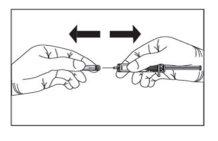
- Потрібно пліскувати шкіру на животі, яку ви очистили, між великим та вказівним пальцями, взявши склад шкіри. Перевірте, що не відпускаєте цей склад, поки не завершите ін'єкцію повністю. Вставте всю голку в склад шкіри та введіть вміст шприца-картриджа, натиснувши на поршень до кінця.
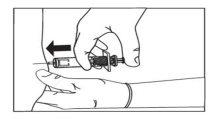
- Видаліть шприц-картридж з місця ін'єкції, тримаючи палець на поршні. Тепер ви можете звільнити пліскування шкіри. Щоб уникнути появи гематом, уникайте масажу місця ін'єкції після ін'єкції.
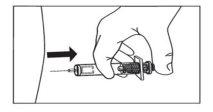
4а) Для шприців-картриджів, обладнаних системою захисту голки. Після закінчення ін'єкції тримайте циліндр шприца-картриджа міцно однією рукою. Іншою рукою тримайте основу циліндра (з крильчаткою) та потягніть до тих пір, поки не почуєте клацання. Тепер голка повністю охоплена та захищена. Обгортка безпеки обладнана засувкою, яка дозволяє розблокувати та заблокувати систему безпеки.
|
|
Видаліть шприц-картридж негайно в призначений контейнер.
4б) Для шприців-картриджів, не обладнаних системою захисту голки
Видаліть шприц-картридж негайно в призначений контейнер.
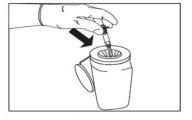
Зміна лікування антикоагулянтами
- Зміна Гепаксану на лікарські засоби для зменшення згортання крові, відомі як антагоністи вітаміну К (наприклад, варфарин)
Ваш лікар попросить провести аналіз крові для визначення параметру, званого INR, і скаже вам, коли потрібно припинити лікування Гепаксаном.
- Зміна лікарських засобів для зменшення згортання крові, відомих як антагоністи вітаміну К (наприклад, варфарин), на Гепаксан
Припиніть використання антагоніста вітаміну К. Ваш лікар попросить провести аналіз крові для визначення параметру, званого INR, і скаже вам, коли потрібно розпочати використовувати Гепаксан.
- Зміна Гепаксану на лікування прямими пероральними антикоагулянтами
Припиніть використання Гепаксану. Розпочніть приймати прямий пероральний антикоагулянт за 0-2 години до того, як вам потрібно буде зробити наступну ін'єкцію, і продовжуйте як зазвичай.
- Зміна лікування прямими пероральними антикоагулянтами на Гепаксан
Припиніть приймати прямий пероральний антикоагулянт. Не розпочинайте лікування Гепаксаном до тих пір, поки не минуть 12 годин після останньої дози прямого перорального антикоагулянту.
Застосування в дітей та підлітків
Безпека та ефективність Гепаксану не були оцінені у дітей та підлітках.
Якщо ви використали більше Гепаксану, ніж потрібно
Якщо ви вважаєте, що використали занадто багато Гепаксану, повідомте негайно вашого лікаря, медсестру або фармацевта, навіть якщо ви не відчуваєте жодних проблем. Якщо дитина випадково ввела або проковтнула Гепаксан, негайно доставьте її до відділення невідкладної допомоги лікарні.
Ви також можете проконсультуватися з Токсикологічною службою, телефон 915620420, вказавши лікарський засіб та кількість, яку було використано.
Якщо ви забули використати Гепаксан
Якщо ви забули зробити ін'єкцію, зробіть її як тільки ви це пам'ятаєте. Не використовуйте подвійну дозу в один і той же день, щоб компенсувати забуті дози. Щоб вам не забути жодної дози, можете бути корисним використання щоденника.
Якщо ви припините лікування Гепаксаном
Якщо в вас є будь-які інші питання щодо використання цього лікарського засобу, проконсультуйтеся з вашим лікарем, фармацевтом або медсестрою. Важливо, щоб ви продовжували отримувати Гепаксан до тих пір, поки ваш лікар не вирішить припинити лікування. Якщо ви припините його використання, може утворитися кров'яний згусток, що може бути дуже небезпечним.
4. Можливі побічні ефекти
Як і всі лікарські засоби, цей лікарський засіб може викликати побічні ефекти, хоча не всі люди їх відчувають.
Важливі побічні ефекти
Припиніть лікування Гепаксаном і повідомте негайно вашого лікаря або медсестру, якщо ви відчуваєте будь-які ознаки важкої алергічної реакції (наприклад, труднощі з диханням, набряк губ, рота, горла чи очей).
Припиніть лікування Гепаксаном і повідомте негайно вашого лікаря або медсестру, якщо ви відчуваєте будь-які з наступних симптомів:
- Розповсюджена червона та луската висипка, з підшкірними вузлами та пухирями, супроводжувана лихоманкою. Симптоми зазвичай з'являються на початку лікування (пустулозна екзантема).
Як і інші подібні лікарські засоби (лікарські засоби для зменшення згортання крові), Гепаксан може викликати кровотечу, яка потенційно може бути небезпечною для життя. У деяких випадках кровотеча може бути неочевидною.
Негайно зв'яжіться з вашим лікарем, якщо:
- Якщо ви помітите будь-який епізод кровотечі, який не зупиняється самостійно
- Якщо ви відчуваєте будь-які ознаки надмірної кровотечі, такі як слабкість, втома, блідість, головокружіння, головний біль чи безпричинний біль.
Ваш лікар може вирішити тримати вас під суворим спостереженням або змінити ваш лікарський засіб.
Ви повинні негайно повідомити вашого лікаря.
- Якщо ви відчуваєте будь-які ознаки блокування кров'яного судини кров'яним згустком, такі як:
- Біль, подібний до судом, червоність, тепло чи набряк у одній з ваших ніг, які є симптомами глибокої венозної тромбози.
- Труднощі з диханням, біль у грудях, втата свідомості чи кашель з кров'ю, які є симптомами легеневого тромбоемболізму.
- Якщо у вас є болюча висипка на шкірі з червоними плямами під шкірою, які не зникають при натисненні.
Ваш лікар може попросити провести аналіз крові для визначення кількості тромбоцитів.
Інші можливі побічні ефекти:
Дуже часті (можуть впливати на більше 1 з 10 людей)
- Кровотеча.
- Збільшення рівня печінкових ферментів.
Часті (можуть впливати до 1 з 10 людей)
- Якщо ви помітите гематоми частіше, ніж зазвичай. Це може бути пов'язано з проблемою крові через низьку кількість тромбоцитів.
- Червоні плями на шкірі. Вони з'являються частіше в місці, де вам було зроблено ін'єкцію Гепаксану.
- Висипка на шкірі (кропив'янка, скулення).
- Червоність та свербіж шкіри.
- Гематома чи біль у місці ін'єкції.
- Зниження кількості червоних кров'яних тілець у крові.
- Збільшення кількості тромбоцитів у крові.
- Головний біль.
Рідкі (можуть впливати до 1 з 100 людей)
- Головний біль різкого початку. Це може бути ознакою кровотечі в мозку.
- Чувствливість до дотику та набряк живота. Це може бути ознакою кровотечі в шлунку.
- Червоні та великі ураження шкіри, нерівномірної форми з або без пухирів.
- Іритація шкіри (локальна іритація).
- Ви можете помітити, що шкіра чи очі стають жовті, а також темніють колір сечі. Це може бути пов'язано з проблемою печінки.
Рідкісні (можуть впливати до 1 з 1 000 людей)
- Важка алергічна реакція. Ознаки цієї реакції можуть включати: висипка на шкірі, труднощі з ковтанням або диханням, набряк губ, обличчя, горла чи мови.
- Збільшення рівня калію у крові. Це більш ймовірно у людей з проблемами нирок чи цукровим діабетом. Ваш лікар може перевірити це шляхом аналізу крові.
- Збільшення кількості еозинофілів (тип білих кров'яних тілець) у крові. Ваш лікар може перевірити це шляхом аналізу крові.
- Випадання волосся.
- Остеопороз (захворювання, при якому кістки можуть ламатися частіше).
- Оніміння, слабкість та больові відчуття у м'язах (особливо у нижній частині тіла), коли було зроблено люмбальну пункцію чи спінальну анестезію.
- Втрата контролю над сечовим міхуром чи кишківником (так, що ви не можете контролювати свої потреби).
- Затвердіння чи вузол у місці ін'єкції.
Повідомлення про побічні ефекти
Якщо ви відчуваєте будь-який побічний ефект, проконсультуйтеся з вашим лікарем, фармацевтом або медсестрою, навіть якщо це можливі побічні ефекти, які не вказані в цьому листку. Ви також можете повідомити про них безпосередньо через Іспанську систему фармакологічної безпеки лікарських засобів для людини: https://www.notificaram.es. Надсилаючи повідомлення про побічні ефекти, ви можете допомогти надати більше інформації про безпеку цього лікарського засобу.
5. Зберігання Гепаксану
Тримайте цей лікарський засіб поза зоною досяжності дітей.
Не використовуйте цей лікарський засіб після закінчення терміну придатності, вказаного на упаковці після "EXP". Термін придатності - останній день місяця, який вказано.
Не використовуйте цей лікарський засіб, якщо ви помітите будь-які видимі зміни у вигляді розчину.
Не заморожуйте.
Шприци-картриджі Гепаксану призначені лише для одноразового використання. Видаліть незастосований лікарський засіб.
Лікарські засоби не повинні викидатися у водопровід чи сміття. Помістіть упаковку та лікарські засоби, які вам не потрібні, у призначений контейнер в аптеці. У разі сумнівів проконсультуйтеся з вашим фармацевтом щодо того, як позбутися упаковки та лікарських засобів, які вам не потрібні. Таким чином, ви допоможете захистити навколишнє середовище.
6. Зміст упаковки та додаткова інформація
Склад Гепаксану
- Кожна попередньо наповнена шприц містить соду енохапарину з анти-Ха активністю 2 000 МЕ (еквівалентно 20 мг) у 0,2 мл води для ін'єкційних препаратів.
- Кожна попередньо наповнена шприц містить соду енохапарину з анти-Ха активністю 4 000 МЕ (еквівалентно 40 мг) у 0,4 мл води для ін'єкційних препаратів.
- Кожна попередньо наповнена шприц містить соду енохапарину з анти-Ха активністю 6 000 МЕ (еквівалентно 60 мг) у 0,6 мл води для ін'єкційних препаратів.
- Кожна попередньо наповнена шприц містить соду енохапарину з анти-Ха активністю 8 000 МЕ (еквівалентно 80 мг) у 0,8 мл води для ін'єкційних препаратів.
- Кожна попередньо наповнена шприц містить соду енохапарину з анти-Ха активністю 10 000 МЕ (еквівалентно 100 мг) у 1 мл води для ін'єкційних препаратів.
- Кожна попередньо наповнена шприц містить соду енохапарину з анти-Ха активністю 12 000 МЕ (еквівалентно 120 мг) у 0,8 мл води для ін'єкційних препаратів.
- Кожна попередньо наповнена шприц містить соду енохапарину з анти-Ха активністю 15 000 МЕ (еквівалентно 150 мг) у 1 мл води для ін'єкційних препаратів.
- Інший складник - вода для ін'єкційних препаратів
Вигляд продукту та вміст упаковки
Гепаксан - це прозорий ін'єкційний розчин без кольору до світло-жовтого в попередньо наповнених шприцах з скла типу I, оснащених голкою для ін'єкції та захисником голки. Шприц може бути оснащений системою захисту голки після ін'єкції.
- Шприци, оснащені системою захисту голки після ін'єкції
- Гепаксан 2 000 МЕ (20 мг)/0,2 мл ін'єкційного розчину в попередньо наповнених шприцах:
Пачки, що містять 2, 6 і 10 попередньо наповнених шприців, а також багаторазові упаковки, що містять 12 (2 пачки по 6), 20 (2 пачки по 10), 24 (4 пачки по 6), 30 (3 пачки по 10), 50 (5 пачок по 10) і 90 (9 пачок по 10) попередньо наповнених шприців.
- Гепаксан 4 000 МЕ (40 мг)/0,4 мл ін'єкційного розчину в попередньо наповнених шприцах:
Пачки, що містять 2, 6 і 10 попередньо наповнених шприців, а також багаторазові упаковки, що містять 12 (2 пачки по 6), 20 (2 пачки по 10), 24 (4 пачки по 6), 30 (3 пачки по 10), 50 (5 пачок по 10) і 90 (9 пачок по 10) попередньо наповнених шприців.
- Гепаксан 6 000 МЕ (60 мг)/0,6 мл ін'єкційного розчину в попередньо наповнених шприцах:
Пачки, що містять 2, 6 і 10 попередньо наповнених шприців з градуйованими маркуваннями, а також багаторазові упаковки, що містять 12 (2 пачки по 6), 20 (2 пачки по 10), 24 (4 пачки по 6), 30 (3 пачки по 10) і 50 (5 пачок по 10) і 90 (9 пачок по 10) попередньо наповнених шприців з градуйованими маркуваннями.
- Гепаксан 8 000 МЕ (80 мг)/0,8 мл ін'єкційного розчину в попередньо наповнених шприцах:
Пачки, що містять 2, 6 і 10 попередньо наповнених шприців з градуйованими маркуваннями, а також багаторазові упаковки, що містять 12 (2 пачки по 6), 20 (2 пачки по 10), 24 (4 пачки по 6), 30 (3 пачки по 10) і 50 (5 пачок по 10) і 90 (9 пачок по 10) попередньо наповнених шприців з градуйованими маркуваннями.
- Гепаксан 10 000 МЕ (100 мг)/1 мл ін'єкційного розчину в попередньо наповнених шприцах:
Пачки, що містять 2, 6 і 10 попередньо наповнених шприців з градуйованими маркуваннями, а також багаторазові упаковки, що містять 12 (2 пачки по 6), 20 (2 пачки по 10), 24 (4 пачки по 6), 30 (3 пачки по 10) і 50 (5 пачок по 10) і 90 (9 пачок по 10) попередньо наповнених шприців з градуйованими маркуваннями.
- Гепаксан 12 000 МЕ (120 мг)/0,8 мл ін'єкційного розчину в попередньо наповнених шприцах:
Пачки, що містять 2, 6 і 10 попередньо наповнених шприців з градуйованими маркуваннями, а також багаторазові упаковки, що містять 30 (3 пачки по 10) і 50 (5 пачок по 10) попередньо наповнених шприців з градуйованими маркуваннями.
- Гепаксан 15 000 МЕ (150 мг)/1 мл ін'єкційного розчину в попередньо наповнених шприцах:
Пачки, що містять 2, 6 і 10 попередньо наповнених шприців з градуйованими маркуваннями, а також багаторазові упаковки, що містять 30 (3 пачки по 10) і 50 (5 пачок по 10) попередньо наповнених шприців з градуйованими маркуваннями.
- Шприци, не оснащені системою захисту голки після ін'єкції
- Гепаксан 2 000 МЕ (20 мг)/0,2 мл ін'єкційного розчину в попередньо наповнених шприцах:
Пачки, що містять 2 і 10 попередньо наповнених шприців.
- Гепаксан 4 000 МЕ (40 мг)/0,4 мл ін'єкційного розчину в попередньо наповнених шприцах:
Пачки, що містять 2 і 10 попередньо наповнених шприців, а також багаторазові упаковки, що містять 30 (3 пачки по 10) попередньо наповнених шприців.
- Гепаксан 6 000 МЕ (60 мг)/0,6 мл ін'єкційного розчину в попередньо наповнених шприцах:
Пачки, що містять 2 і 10 попередньо наповнених шприців з градуйованими маркуваннями, а також багаторазові упаковки, що містять 30 (3 пачки по 10) попередньо наповнених шприців з градуйованими маркуваннями.
- Гепаксан 8 000 МЕ (80 мг)/0,8 мл ін'єкційного розчину в попередньо наповнених шприцах:
Пачки, що містять 2 і 10 попередньо наповнених шприців з градуйованими маркуваннями, а також багаторазові упаковки, що містять 30 (3 пачки по 10) попередньо наповнених шприців з градуйованими маркуваннями.
- Гепаксан 10 000 МЕ (100 мг)/1 мл ін'єкційного розчину в попередньо наповнених шприцах:
Пачки, що містять 2 і 10 попередньо наповнених шприців з градуйованими маркуваннями, а також багаторазові упаковки, що містять 30 (3 пачки по 10) попередньо наповнених шприців з градуйованими маркуваннями.
- Гепаксан 12 000 МЕ (120 мг)/0,8 мл ін'єкційного розчину в попередньо наповнених шприцах:
Пачки, що містять 10 попередньо наповнених шприців з градуйованими маркуваннями, а також багаторазові упаковки, що містять 30 (3 пачки по 10) попередньо наповнених шприців з градуйованими маркуваннями.
- Гепаксан 15 000 МЕ (150 мг)/1 мл ін'єкційного розчину в попередньо наповнених шприцах:
Пачки, що містять 10 попередньо наповнених шприців з градуйованими маркуваннями, а також багаторазові упаковки, що містять 30 (3 пачки по 10) попередньо наповнених шприців з градуйованими маркуваннями.
Шприци з 6 000 МЕ (60 мг)/0,6 мл, 8 000 МЕ (80 мг)/0,8 мл, 10 000 МЕ (100 мг)/1 мл, 12 000 МЕ (120 мг)/0,8 мл і 15 000 МЕ (150 мг)/1 мл мають градуйовані маркування.
Можливо, тільки деякі розміри упаковок будуть доступні для продажу.
Власник дозволу на маркетинг та відповідальний за виробництво
Власник дозволу на маркетинг
Chemi S.p.A
Via dei Lavoratori 54,
20092 Cinisello Balsamo, Мілан
Італія
Відповідальний за виробництво
Italfarmaco S.p.A
Viale Fulvio Testi 330
20126 Мілан
Італія
або
EUROFINS BIOLAB S.R.L.
Via Bruno Buozzi, 2 - Vimodrone - 20090 - Італія
Для отримання додаткової інформації про цей лікарський засіб зверніться до місцевого представника власника дозволу на маркетинг:
ITALFARMACO S.A.
C/ San Rafael 3,
28108 Alcobendas
Мадрид
Іспанія
Цей лікарський засіб дозволений в державах-членах Європейського економічного простору під наступними назвами:
Бельгія: Ghemaxan
Німеччина: Hepaxane
Данія: Ghemaxan
Греція: Havetra
Іспанія: Hepaxane
Фінляндія: Ghemaxan
Італія: Ghemaxan
Нідерланди: Ghemaxan
Норвегія: Ghemaxan
Австрія: Ghemaxan
Франція: Ghemaxan
Ірландія: Ghemaxan
Швеція: Ghemaxan
Португалія: Hepaxane
Угорщина: Hepaxane
Румунія: Hepaxane
Словаччина: Ghemaxan
Дата останнього перегляду цієї інструкції: Січень 2023
Інші джерела інформації
Детальна інформація про цей лікарський засіб доступна на сайті Іспанського агентства лікарських засобів і медичних продуктів (AEMPS) http://www.aemps.gob.es.
Ви можете отримати детальну та актуальну інформацію про те, як застосовувати цей лікарський засіб, скануючи код QR, включений до інструкції та упаковки, за допомогою свого мобільного телефону (смартфона). Ви також можете отримати доступ до тієї ж інформації на наступних інтернет-адресах
Гепаксан 2 000 МЕ (20 мг)/0,2 мл https://cima.aemps.es/info/83293
| Гепаксан 4 000 МЕ (40 мг)/0,4 мл https://cima.aemps.es/info/83292
|
Гепаксан 6 000 МЕ (60 мг)/0,6 мл https://cima.aemps.es/info/83291
| Гепаксан 8 000 МЕ (80 мг)/0,8 мл https://cima.aemps.es/info/83294
|
Гепаксан 10 000 МЕ (100 мг)/1 мл https://cima.aemps.es/info/83288
| Гепаксан 12 000 МЕ (120 мг)/0,8 мл https://cima.aemps.es/info/83290
|
Гепаксан 15 000 МЕ (150 мг)/1 мл https://cima.aemps.es/info/83289
|

Скільки коштує ГЕПАКСАН 12 000 МО (120 мг)/0,8 мл РОЗЧИН ДЛЯ ІН'ЄКЦІЙ У ПЕРЕДНАПОВНЕНИХ ШПРИЦАХ в Іспанії у 2025 році?
ГЕПАКСАН 12 000 МО (120 мг)/0,8 мл РОЗЧИН ДЛЯ ІН'ЄКЦІЙ У ПЕРЕДНАПОВНЕНИХ ШПРИЦАХ коштує в середньому 86.05 євро у грудень, 2025 році. Ціна може змінюватися залежно від регіону, аптеки та наявності рецепта. Рекомендуємо перевіряти актуальну вартість у місцевих аптеках або через онлайн-сервіси.
- Країна реєстрації
- Середня ціна в аптеках86.05 EUR
- Діючі речовини
- Потрібен рецептТак
- Виробник
- Інформація є довідковою і не є медичною порадою. Перед прийомом будь-яких препаратів обов'язково проконсультуйтеся з лікарем. Oladoctor не несе відповідальності за медичні рішення, прийняті на основі цього контенту.
- Альтернативи до ГЕПАКСАН 12 000 МО (120 мг)/0,8 мл РОЗЧИН ДЛЯ ІН'ЄКЦІЙ У ПЕРЕДНАПОВНЕНИХ ШПРИЦАХФорма випуску: РОЗЧИН ДЛЯ ІН'ЄКЦІЙ, 100 мг (10000 МО) еноксапарину натрію/млДіючі речовини: enoxaparinВиробник: Sanofi Aventis S.A.Потрібен рецептФорма випуску: РОЗЧИН ДЛЯ ІН'ЄКЦІЙ, 120 мг (12000 МО) /0,8 млДіючі речовини: enoxaparinВиробник: Sanofi Aventis S.A.Потрібен рецептФорма випуску: РОЗЧИН ДЛЯ ІН'ЄКЦІЙ, 150 мг (15000 МО) /1 млДіючі речовини: enoxaparinВиробник: Sanofi Aventis S.A.Потрібен рецепт
Аналоги ГЕПАКСАН 12 000 МО (120 мг)/0,8 мл РОЗЧИН ДЛЯ ІН'ЄКЦІЙ У ПЕРЕДНАПОВНЕНИХ ШПРИЦАХ в інших країнах
Найкращі аналоги з тією самою діючою речовиною та терапевтичним ефектом.
Аналог ГЕПАКСАН 12 000 МО (120 мг)/0,8 мл РОЗЧИН ДЛЯ ІН'ЄКЦІЙ У ПЕРЕДНАПОВНЕНИХ ШПРИЦАХ у Польща
Аналог ГЕПАКСАН 12 000 МО (120 мг)/0,8 мл РОЗЧИН ДЛЯ ІН'ЄКЦІЙ У ПЕРЕДНАПОВНЕНИХ ШПРИЦАХ у Україна
Лікарі онлайн щодо ГЕПАКСАН 12 000 МО (120 мг)/0,8 мл РОЗЧИН ДЛЯ ІН'ЄКЦІЙ У ПЕРЕДНАПОВНЕНИХ ШПРИЦАХ
Консультація щодо дозування, побічних ефектів, взаємодій, протипоказань та поновлення рецепта на ГЕПАКСАН 12 000 МО (120 мг)/0,8 мл РОЗЧИН ДЛЯ ІН'ЄКЦІЙ У ПЕРЕДНАПОВНЕНИХ ШПРИЦАХ – за рішенням лікаря та згідно з місцевими правилами.




